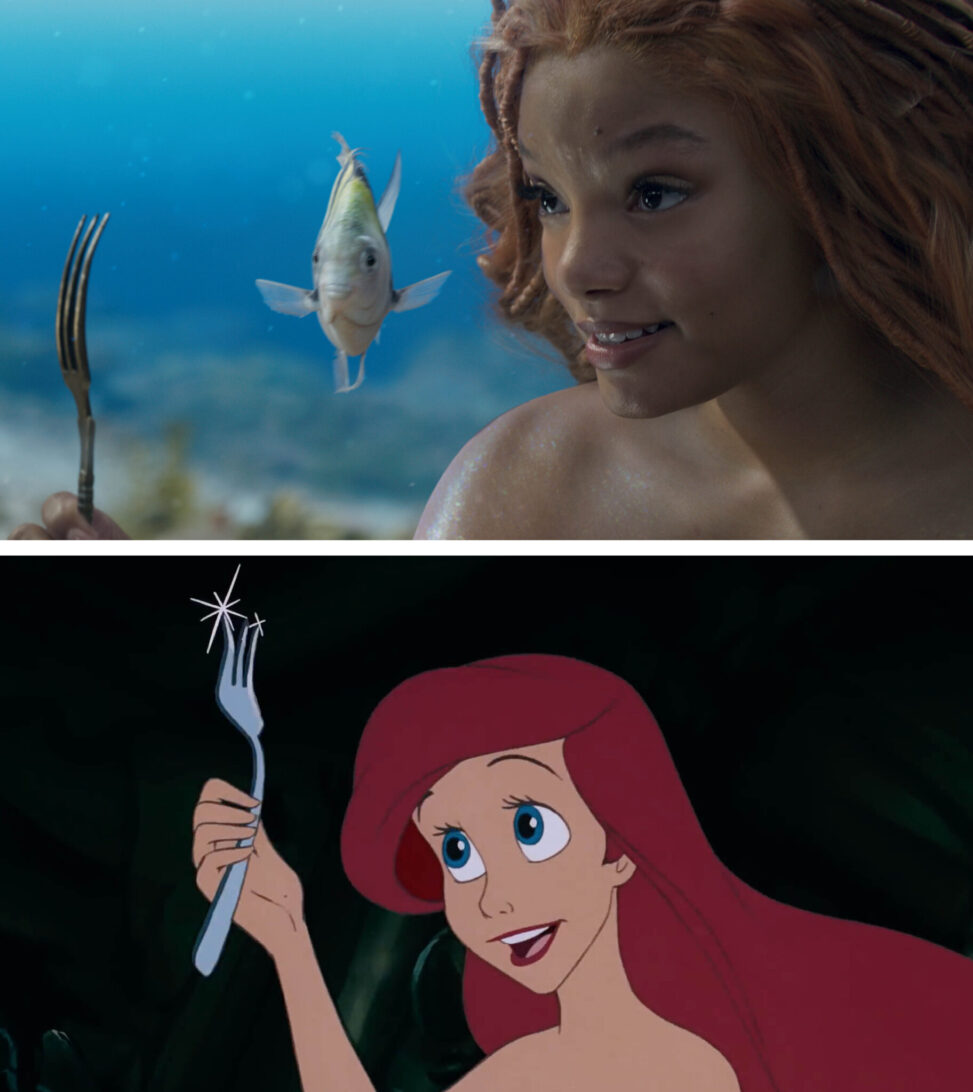The Little Mermaid (1989) is a popular Disney cartoon film/musical that stars a Caucasian, sixteen-year-old mermaid named Ariel. The 2023 remake utilized CGI and real actors to give the character of ‘Ariel’ a new look and updated agency. Receiving a mix of praise and criticism from audiences, the reboot cast Ariel as a young, African American woman. While some considered this race change to be progressive and promote diversity on-screen, others were expressively disappointed with the visible change from their expectations of the original Ariel. Further, there are critiques that the remake did not diversify the plot or character enough to complement modern day. The recent depiction of this character highlights differences in race and agency, while upholding her age, gender, and culture from the original.
Ariel in both films is curious and rebellious, fascinated with the human world above her underwater society, and strives to be “part of their world”. Her main motivation remains a romantic relationship with her love interest, Prince Eric. She trades her voice for human legs to Ursula, a sea witch, to temporarily have a chance to win his affection and experience land.
The change in Ariel’s race brings people of color into the center narrative as a hero with complex character interest. The plotline is kept very similar to the original version, unaltering the plot based on her skin color. This new representation “affirm[s] that black looks are beautiful and worthy of Disney princess status.” This modern recasting has boded well with young audiences of color, particularly with seeing themselves being represented on screen and in a desirable role. Specifically, this study found that “children, particularly those of Latino or Afro-descendant heritage, expressed positive emotions when they could relate to and find representation in a historically Caucasian Disney character. “ Being able to see oneself in a leading, independent female character onscreen opens the scope of what is possible for oneself in the future. Furthermore, they observed that self-esteem and cultural identity have a moderately strong relationship, “highlighting the importance of ethnic recognition in the process of valuing the child’s self and us concept.” Representations of a minority group when portrayed positively are especially important because they further promote feelings of belonging and pride in one’s group.
While the modern depiction of Ariel is black and sporting dreadlocks, the lack of cultural nuance, in addition to this visual change and has received criticism for both diversifying too much and not enough. The story takes place in the Caribbean yet lacks inclusion of the social and cultural backdrop of this environment. Niall Richardson shares that “the 2023 remake can be critiqued for reducing race to a signifier that has no socio-political or historical significance.” Furthermore, the race change appears to be mainly surface level, “reduc[ing] race merely to a visual aesthetic.” Disapproving feedback to Ariels’ new look is founded both in “a lack of genuine diversity or a sense of ‘forced inclusion’” and the lack of “adhering to the standards previously established by Disney.” Ariel’s new representation is tied to aesthetic, cultural, and nostalgic critique.
A refreshing change in The Little Mermaid (2023) character depiction is Ariel’s newfound agency. Gone are the days of a damsel in distress who needs others to do actions for her. A climactic change happens when, instead of Eric steering the ship to impale Ursula (1998) , Ariel commandeers the wheel and does this herself (2023) . Further, she takes back her shell necklace that holds her voice from Ursula, when in the original version, one of her underwater friends takes it back. Most interestingly, Ariel is given an internal dialogue when she is unable to speak on land, giving a look into her emotions and humanizing her during this transitional phase. These few changes give Ariel’s character greater power and autonomy over her being.
Although Ariels agency is promoted in her modern construction, her traditionalist and anti-feminist motivations surrounding love has remained intact with the remake. The plot is centered on her motivations for a romantic relationship above much else. Ariel loses her community, identity, and ability in a seemingly necessary trade to progress a relationship with her romantic idol. It upholds a narrative that love is something that one needs to suffer and inherently change for. The minimal changes to remain rebellious in modern-day narratives surrounding romantic love ignore the weight of “…global demands for gender equality promoted by government institutions and social movements.” This perpetuates old stereotypes onto newer generations that women need to change dramatically, while men don’t at all, and that romantic love requires great tribulation and sacrifice for women.
The Little Mermaid (2023) adds more diversity to this beloved character and allows more self-representation on screen for children. It falls short on modernizing values surrounding love and recognizing cultural variety. Overall, it was a positive transition for the representation of women of color on-screen, particularly for children who appear to be less judgmental and admire variations of character representation and expression. While Disney attempted to diversify and modernize The Little Mermaid, there are more aspects to her creation that require consideration in her liberation.
Notes
Catalina Gayà Morlà and Carme Ferré-Pavia, “Disney Princesses and Romantic Love: A Narrative That Perpetuates Patriarchal Domination.” Quarterly Review of Film & Video 42, no. 3 (April 2025): 675. doi:10.1080/10509208.2024.2406968.
Niall Richardson. “Part of Whose World? How The Little Mermaid (2023) Attempts to Revise the Racist Tropes of the 1989 Animated Film Musical.” Alphaville: Journal of Film and Screen Media, no. 27 (July 2024): 103. doi:10.33178/alpha.27.08.
Richardson. “Part of Whose World?” 101.
Bonilla-del-Río and Vizcaíno-Verdú, “”The Little Mermaid Looks Like Me!””, 63.
Bonilla-del-Río and Vizcaíno-Verdú, “”The Little Mermaid Looks Like Me!””, 65.
Richardson. “Part of Whose World?” 103.
Richardson. “Part of Whose World?” 103.
Bonilla-del-Río and Vizcaíno-Verdú, “”The Little Mermaid Looks Like Me!””, 67.
The Little Mermaid, directed by Ron Clements and John Musker (Walt Disney Pictures, 1989), 1:14:36.
The Little Mermaid, directed by Rob Marshall (Walt Disney Pictures, 2023), 1:52:55.
Gayà Morlà and Ferré-Pavia, “Disney Princesses and Romantic Love”, 684.
Gayà Morlà and Ferré-Pavia, “Disney Princesses and Romantic Love”, 684.
Gayà Morlà and Ferré-Pavia, “Disney Princesses and Romantic Love”, 687.
Bibliography
Bonilla-del-Río, Mónica and Arantxa Vizcaíno-Verdú. ““The Little Mermaid Looks Like Me!”: Cross-Cultural Diversity, Inclusion and children’s Self-Esteem on TikTok.” Psychology, Society & Education 15, no. 3 (2023): 57-70. doi:https://doi.org/10.21071/pse.v15i3.
16098.
Clements, Ron and Musker, John, directors. The Little Mermaid. Walt Disney Pictures, 1989. 1hr., 23 min.
Gayà Morlà, Catalina and Carme Ferré-Pavia. “Disney Princesses and Romantic Love: A Narrative That Perpetuates Patriarchal Domination.” Quarterly Review of Film & Video 42, no. 3 (April 1, 2025): 675–90. doi:10.1080/10509208.2024.2406968.
Marshall, Rob, director. The Little Mermaid. Walt Disney Pictures, 2023. 2hr., 15 min.
Richardson, Niall. “Part of Whose World? How The Little Mermaid (2023) Attempts to Revise the Racist Tropes of the 1989 Animated Film Musical.” Alphaville: Journal of Film and Screen Media, no. 27 (July 1, 2024): 94–109. doi:10.33178/alpha.27.08.


Anudi Kumarasinghe
The SPLOT submission comparing the 1989 and 2023 versions of The Little Mermaid offers a detailed and balanced analysis of how Ariel’s character has evolved over time. The Leah does a great job highlighting the major similarities between the two versions, like Ariel’s curiosity, rebelliousness, and desire to explore the human world, while also pointing out the major differences in how her race and agency are represented in the remake. What stands out most is how the writer connects these changes to larger cultural discussions about representation and identity, especially for young audiences of color.
The main arguments focus on three key ideas: the significance of race in the 2023 version, Ariel’s increased independence, and how the core romantic motivations of the character remain tied to outdated gender expectations. The student uses a solid range of scholarly sources, such as Richardson, Bonilla-del-Río and Vizcaíno-Verdú, and Gayà Morlà and Ferré-Pavia, to support these points. The references fit naturally into the analysis and show that the student really engaged with academic perspectives, rather than just summarizing them.
One thing that could make the analysis even stronger would be a closer look at Disney’s intentions behind the changes—whether the new Ariel was part of a genuine push for diversity or more of a marketing move. It also might have been interesting to discuss how the visual design choices, like costume and lighting, reflect Ariel’s transformation.
Overall, the submission is insightful and clearly written. The two chosen images effectively support the discussion, showing both continuity and change in Ariel’s character. It’s a thoughtful comparison that balances critique with appreciation, showing a strong understanding of both film and cultural context.